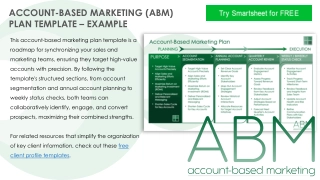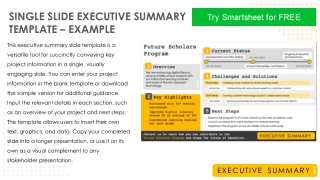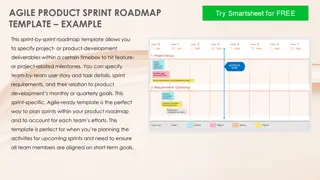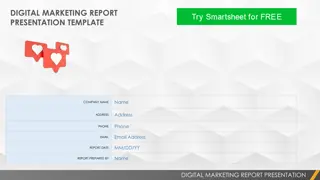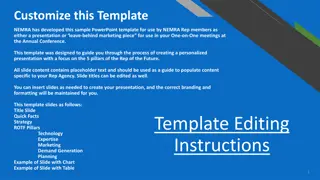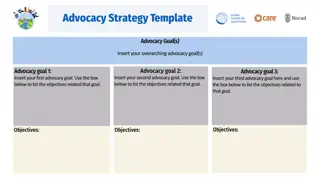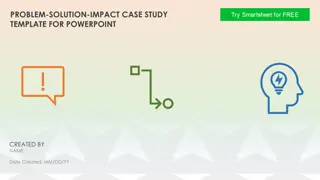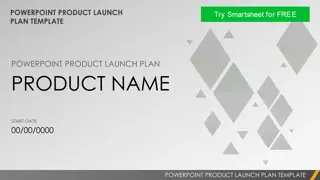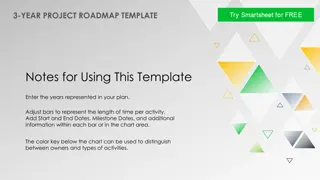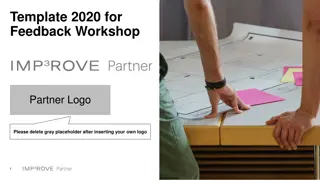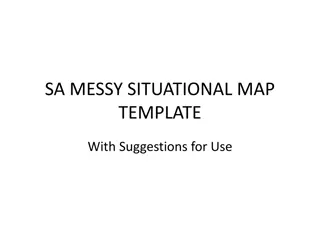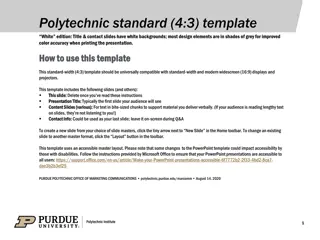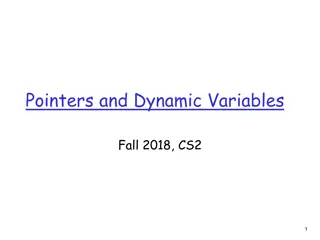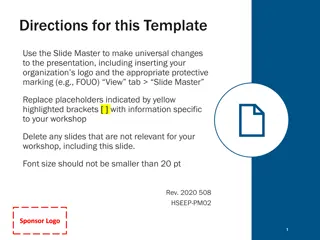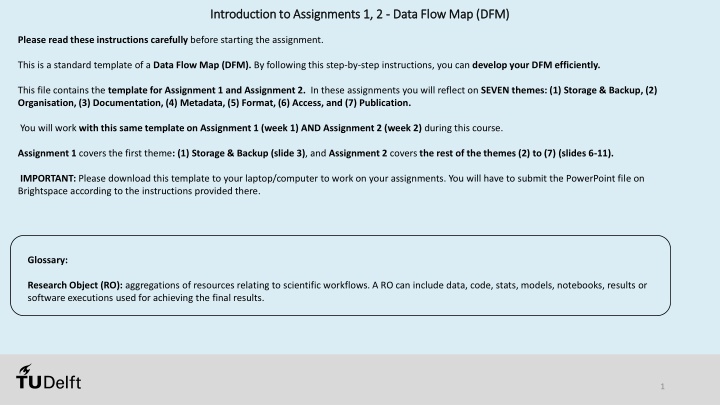
Efficient Data Flow Map (DFM) Assignment Instructions
Follow a step-by-step guide to efficiently complete Assignments 1 and 2, focusing on themes like storage, organization, documentation, and more, using a Data Flow Map (DFM) template. Complete tasks related to research data objects, actions, flags, and reflecting on the theme of storage and backup. Save your work accordingly for submission.
Download Presentation

Please find below an Image/Link to download the presentation.
The content on the website is provided AS IS for your information and personal use only. It may not be sold, licensed, or shared on other websites without obtaining consent from the author. If you encounter any issues during the download, it is possible that the publisher has removed the file from their server.
You are allowed to download the files provided on this website for personal or commercial use, subject to the condition that they are used lawfully. All files are the property of their respective owners.
The content on the website is provided AS IS for your information and personal use only. It may not be sold, licensed, or shared on other websites without obtaining consent from the author.
E N D
Presentation Transcript
Introduction to Assignments 1, 2 Introduction to Assignments 1, 2 - - Data Flow Map (DFM) Data Flow Map (DFM) Please read these instructions carefully before starting the assignment. This is a standard template of a Data Flow Map (DFM). By following this step-by-step instructions, you can develop your DFM efficiently. This file contains the template for Assignment 1 and Assignment 2. In these assignments you will reflect on SEVEN themes: (1) Storage & Backup, (2) Organisation, (3) Documentation, (4) Metadata, (5) Format, (6) Access, and (7) Publication. You will work with this same template on Assignment 1 (week 1) AND Assignment 2 (week 2) during this course. Assignment 1 covers the first theme: (1) Storage & Backup (slide 3), and Assignment 2 covers the rest of the themes (2) to (7) (slides 6-11). IMPORTANT: Please download this template to your laptop/computer to work on your assignments. You will have to submit the PowerPoint file on Brightspace according to the instructions provided there. Glossary: Research Object (RO): aggregations of resources relating to scientific workflows. A RO can include data, code, stats, models, notebooks, results or software executions used for achieving the final results. 1
Instructions for Assignment 1 Instructions for Assignment 1 DFM #1 DFM #1 Here we go! These are the FOUR steps to follow to complete Assignment 1. Step 1: Research data/objects. 1-1. Write a descriptive name for each research data/object you will collect or work with during your project in the respective boxes on slide 3 e.g. Interview videos, Sequencing data, Sensor data, Interview transcript, Design sketches, etc.; 1-2 Fill out the type of research data/object e.g. dataset, code, model, software executable, images, etc.; 1-3. Write a short description reflecting on the following two questions: (1) What is the nature of the research data/object? (2) How is it collected/created? e.g. recording videos collected in a in-person interview at the Company X, acoustic signals from material stress detected using acoustic sensors; 1-4. Write the format and size of each research data/object using a standard measurement, e.g. MPG4; gigabyte or GB. Note: Do not restrict yourself to list only five research data/objects! Please provide a comprehensive list. If you would like to extend the list, you can do so by duplicating the slide we have provided by clicking on the icon New Slide . Step 2: Actions. Use the green action arrows for each research data/object. Go to the Toolbox on slide 4 "Action". Choose the action (green arrows) from the list for each research data/object. Copy and paste it in on the template (slide 3). Step 3: Flags. Use the red flags to indicate important characteristics of the research data/object that might influence how you need to manage it. Go to the Toolbox on slide 4 "Flags . Choose a flag (red flags) from the list for each research data/object which has a relevant characteristic. Copy and paste it on the template (slide 3), accordingly. Note: If you need more options for filling out 'Actions' and 'Flags' feel free to modify/add new arrows and flags. Step 4: Reflect on Theme Storage & Backup by answering questions Q1-Q3. You can find them in the next slide (slide3). Note: Each question (Q1, Q2, Q3) can be responded individually for each research data/object, or at a group level. 2 Attention! Do not forget to save this template as: Assignment 1- {your name} and upload it in the corresponding group on Brightspace!
Theme (1) Storage & Backup Step 4 Use the red flags in the Toolbox (slide 4) to indicate if a research data/object has important characteristics that might influence how you need to manage it. Fill out the respective boxes with following information (see slide 2 for some tips and examples): 1) Add a descriptive name of research data/objects 2) Add the type of research data/objects 3) Add the format and size of each research data/object 4) Add a short description Step 1 Step 3 Reflect about the Theme Storage and Backup . Think about a strategy to securely store research data/objects of your project and add your choice and considerations to the template, answering the three questions in the boxes below. Q1. Where will you store the research data/objects? Step 2 Indicate actions to the research data/object. Use the Toolbox (slide 4) e.g. Restricted access e.g. Merge Q2. Where will you store the master copy? Flag s Action Flag s Action Q3. What infrastructure will you use as a backup? Flag s Action Flag s Action 3
Flags Actions Create Delete Analyze Confidential data Collect Transcribe Anonymize Commercial data TOOLBOX Personal data Pseudony misation Publish Copy Closed access Merge Convert Re-use Check usage rights 4
Instructions for Assignment 2 Instructions for Assignment 2 DFM #2 DFM #2 Please read these instructions carefully before starting the assignment. In Assignment 1 you reflected on the Theme (1) Storage & Backup (slide 3) for the research data/objects of your project. Now it is time to complete Assignment 2. These are the TWO steps you will need to follow. Step 1. Review the Theme (1) Storage & Backup (slide 3) and make necessary updates to your research data/objects according to the feedback of your peers and instructors. Step 2. Continue developing your DFM by reflecting on Themes (2) to (7): (2) Organisation, (3) Documentation, (4) Metadata, (5) Format, (6) Access, and (7) Publication. For that, read the instructions of each theme, and fill out the respective boxes. Please note, that all these themes relate to the research data/objects you listed in Assignment 1 (slide 3). Tip: Go through the contents in Module 3 and 4 before proceeding to complete the assignment. Here is a summary of each module: Module 3: You learned about the five key elements of the FAIR principles (i.e. Documentation & Metadata, Interoperability, Access to the research data/objects of your project, Persistent Identifiers and Licences) Module 4: You explored some best practices for the organisation, documentation and publication of research data/objects. 5 Attention! Do not forget to save this template as: Assignment 2- {your name} and upload it in the corresponding group on Brightspace!
Theme (2) Data organisation Step 2 - Reflect on the folder structure for the research data/objects of your project. In which folder will you place the research objects you listed. Please add a graphical schematic representations as in the example below. Reply to Q2. Good documentationstartswith good organisation of researchdata/objects. Step 1 - Reflect on the naming convention for the researchdata/object of your project. Think about some naming conventions, or standards for labelling the research data/object you listed on slide 3. You can select one convention to use across all of the research data/objects or define different ones for each of them (recommended). Either way, remember that you must be consistent once you choose a naming convention. Reply to Q1. Recommendation: Go back to Module 4 and watch the video on data organization, if you need to remember the best practices for file naming conventions. You can also take a look at the examples of research compendium here. You can also take a look at the examples of research compendium here. examples of research compendium here Step 2 Recommendation: Go back to Module 4 and watch the video on data organisation, if you need to remember the best practices for file naming conventions. You can also have a look at examples of naming conventions here. You can also have a look at examples of naming conventions here. Q2. What folder structure will you use for your project? (and how does the research data/objects from slide 3 fit in there) examples of naming conventions here Example: Step 1 README.md My project/ README.md data_raw/ 0.1_mydata.csv data_clean/ 0.1_mydata_clean.csv code/ scripts.py figures/ flowchart.jpg publication/ manuscript_v1.0.doc Q1. What naming convention are you going to apply? (show us an example based on your expected research data/objects from slide 3). Feel free to add any additional remarks. 6
Theme (3) Documentation Answer Q1 and Q2 for each research data/object listed on slide 3. Step 1 Q1. What type of documentation do you need to generate/write? (e.g., metadata, data collection process or methodology, data dictionary, readme files) Think about the types and tools of documentation. What type of documentation is relevant for the research data/objects you will be collecting/creating? You may need to record only metadata or readme files for some research data/objects, while others demand a data dictionary or more extensive information about a process of data collectionor tools. Step 1 - Reflect on the types and tools of documentation you will use for research data/objects, then answer Q1 and Q2. Note: Please reflect on the documentation type/tool for each research data/object listed on slide 3. For each item, specify its descriptive name (e.g. Interview videos). If there is shared information regarding the documentation type/tool for multiple research data/objects, you can group them first and then indicate the type/tool for documentationyou will use. Q2. What tools are helpful to generate/write your documentation? Step 2 - If you have more information regarding documentation (e.g. link to the README template you will adapt), write it down as an answer for Additional remarks'. Recommendations: You can refer to the following links to know concrete examples of documentation types and tools: Popular tools for code documentation Readme file template Cornell University Readme files standards from 4TU Bricks (a uniform metadata schema for buildings) Model and data cards for learning models Jupyter notebooks TU Delft Electronic Lab Notebooks (ELNs) Quarto converts markdown to websites, pdfs, ebooksand many other things Step 2 Add any Additional remarks
Theme (4) Metadata Step 1 Answer question 1 and 2 Think about the metadata that you should add to the research data/objects of your project. Do you need generic metadata (e.g., date of collection/creation, author) or more specific ones (e.g., location of data collection, instrument model, name of the softwareto read the data, etc.)? Q1. List the relevant metadata you need to record for each research data/object Step 1 Reflect on relevant metadata to add to the research data/objects of your project and a standard existing in your discipline (if any), then answer Q1 and Q2. Step 2 - If you have more information regarding metadata, write it down as an answer in the box for Additional remarks Q2. Indicate if you will use a metadata standard existing in your discipline. If applicable, write the link to the standard Recommendations: You can visit the FAIRsharing.org website to check if a metadata standard exists for your discipline or type of data. Here are other links that may help you to search for a standard: Project Object Model (POM) for Marven Model and data cards for machine learning models Step 2 Additional remarks CodeMeta for software Metadata assistant for hugging ML models
Theme (5) File formats Step 1 Answer question s 1, 2 and 3: Q1. If your research data/object is in an open format, write the details, e.g., code for analysing sensor - Python In Assignment 1, you filled out the format in which you will collect/create the different research data/objects of your project. Go back to the information on slide 3, and think if you can convert those formats to an open file format. Remember that an open file format would increase the interoperability of the research data/object, if anybody would like to reuse them. Step1 - Reflect on the file formats of each research data/objects of your project, and answer Q1-Q3. Q2. If your research data/object is in a proprietary format, can you convert the proprietary formats to an open format? If yes, to which open format?If not, what are the reasons? Recommendations: Recommendations: Python modules conversion for Matlab users Python modules conversion for Matlab users Python modules conversion for Matlab users List of preferred file formats provided by 4TU.ResearchData List of preferred file formats provided by 4TU.ResearchData List of preferred file formats provided by 4TU.ResearchData Q3. If the research data/object is in a proprietary format, what information/software would others need to reuse them? 9
Theme (6) Access Step 1 Answer questions 1, 2 and 3 Q1. Who will have access to research data/objects during the project? It is essential to reflect on the accessibility of research data/objects of your project. It would help if you elaborate on who, when and how will access them. Also, it is important to reflect on the possibility/permission to publish the data/output (e.g., model you created, data you collected) before preparing the research data/objects for publication. You may need to take additional precautions and/or work on anonymizing the research data/objects before making them available, especially if you are working with confidential information and/or personal data. Q2. If others than you will have access to the research data/object during the project, how will you share all of them (e.g. SURFdrive, SURF file sender, Project Data (U:) drive, etc.)? Step 1. Reflect on the accessibility of each research data/objects of your research project that are listed on slide 3, and answer Q1-Q3. Note: For each item, specify its descriptive name (e.g. Interview videos access granted only to me and my supervisor only). If there is shared information regarding the accessibility of multiple research data/objects, you can group them first and then indicate the access (e.g. interview videos, interview transcripts - access granted to me and my supervisor only). Recommendations: Q3. At the end of the project the research data/objects will be: open , restricted access or restricted access with public metadata ? Decision Tree - Making Qualitative Data Reusable (Version 2) DANS Section 7 of the 4TU.ResearchData Data collection Policy can provide guidance on level of privacy that research data/objects may have. 10
Theme (7) Data publication Step 1 Answer question 1, 2, 3 and 4 Q1. If the research data/object is marked as open , in which repository would you publish it? On Theme (6) Access, you reflected on accessibility to your research data/objects. Based on your answer, you further reflect on how you handle each research data/objects upon publication. Step 1. Reflect on the publication of your research data/objects, and answer Q1-Q4. Note: Please reflect on the on the publication of each research data/object listed on slide 3. For each item, specify its descriptive name (as shown in the example on the right-hand side). If there is shared information regarding the publication of multiple research data/objects, please present this information alongside the respective list of research data/objects. Q2. If the research data/object is marked as restricted access , how could other people request for access to it after you finish your project? Q3. If the research data/object is marked restricted access with public metadata , where will you publish the metadata and where will you store the research data/object? Recommendations TU Delft researchers can publish up to 1 TB of data per year for free on 4TU.ResearchData. You can synchronise your GitHub/GitLab repository: https://data.4tu.nl/ A General purpose repository that provides a DOI and allows to assign a usage licence is Zenodo. You can synchronise your GitHub repository following this instructions: https://docs.github.com/en/repositories/archiving-a-github- repository/referencing-and-citing-content Q4. Do the repositories you plan to use provide a DOI for the research data/object? Does it allow you to provide a usage licence? If so, which licence would you use?

